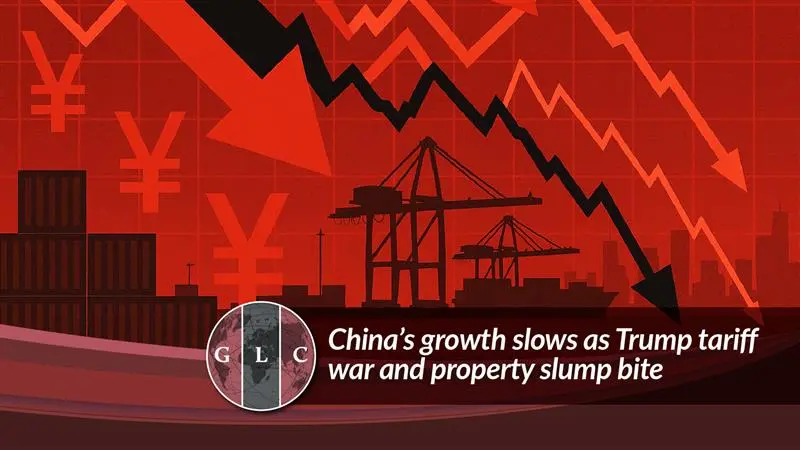China’s growth trajectory has weakened as two powerful forces converge: an intensified tariff campaign from the United States and the ongoing drag from a troubled property market. Together, these factors are reducing domestic consumption, slowing investment, and altering patterns of global trade, with real consequences for shipping volumes, routing decisions, and inventory strategies worldwide.
For supply-chain and logistics leaders, the shift is practical, not theoretical. Companies are accelerating “China+1” sourcing strategies, carriers are trimming or rerouting sailings to protect yields, and ports are feeling the knock-on effects of changing export demand.
What the numbers tell us
China’s GDP expanded year-on-year by 4.8% between July and September 2025, down from a 5.2% pace in Q2. Those headline figures mask a mixed picture underneath: industrial production remains a relative bright spot, while consumption and property investment are lagging. Analysts point to weak household and business confidence, and a property sector still wrestling with a debt hangover.
At the same time, trade flows are shifting. Exports to the United States have fallen sharply, reported month-on-month and year-on-year drops point to a notable rerouting and diversification of Chinese export destinations, with shipments to parts of Europe, Southeast Asia, and Africa expanding as firms seek alternative markets.
For supply chain leaders, especially those managing import-heavy operations into North America and Europe, these macro signals matter in concrete ways:
-
Capacity and pricing volatility. As shipment volumes move between lanes and carriers reallocate sailings and equipment, spot rates and capacity availability can swing unexpectedly. Carriers adjust capacity to protect yields, which can cause container shortages on some routes and slack on others.
-
Route and supplier diversification accelerates. Companies pursuing “China+1” strategies will continue to shift sourcing toward Southeast Asia, Mexico, and other nearshore locations. That’s not simply a cost play, it’s an operational resilience decision that affects lead times, customs complexity, and inventory policy.
-
Demand-side shifts. Weak domestic consumption in China can lower upstream demand for certain commodities and intermediate goods, creating knock-on effects for ports, container repositioning, and carrier scheduling on affected corridors.
Practical steps for logistics and procurement teams
Policy shifts and uneven growth mean that tactical responses are as important as strategic repositioning. Practical measures we recommend for mid-to-large shippers:
Stress-test your corridors. Map which SKUs and lanes are most exposed to China-US tariff dynamics or to reductions in Chinese domestic demand. Quantify lead-time and cost impact under multiple scenarios.
Prioritize multimodal options. Where ocean capacity is tightening or rates spike, evaluate air-ocean combos, rail (where available), or inland consolidation to maintain service levels without excessive cost.
Strengthen nearshore playbooks. For categories suited to nearshoring, build supplier onboarding templates, customs playbooks, and transit-time models for Mexico and other regional hubs. These reduce surprises when execution shifts.
Increase visibility and agility. Invest in end-to-end tracking and exception management so you can reroute or rebook quickly when carriers change schedules or when container imbalances occur.
Work closely with customs and trade compliance. Tariff regimes and reciprocal measures evolve quickly, tighter coordination between sourcing, customs brokerage, and trade compliance prevents costly surprises at the border.
What carriers and ports are likely to do next
Carriers typically respond to trade shocks by reallocating capacity and rationalizing services. That response stabilizes yields but creates short-term disruption for shippers who lack flexibility. On the port side, volume shifts may produce localized congestion in expanding hubs while reducing utilization elsewhere, a pattern that requires dynamic routing and contingency plans from logistics teams.
Strategic view: balance cost, speed, and resilience
For many companies, the right answer won’t be an all-in move away from China, the country remains critical for certain value chains and for global manufacturing scale. The strategic imperative today is balance: keep low-cost, high-volume manufacturing where it makes sense, while building parallel sourcing and distribution options that reduce single-point exposure and keep service levels intact during shocks.
How GLC helps
At Global Logistical Connections (GLC), we help clients translate macroeconomic signals into operational playbooks. Whether you need to reroute shipments, pilot nearshoring to Mexico, or strengthen customs and warehousing capabilities, GLC provides:
- Integrated freight forwarding (ocean, air, and intermodal) to quickly replan lanes.
- Customs brokerage and trade compliance to mitigate tariff and documentation risk.
- Warehousing and distribution across North and Latin America for shorter lead times and regional fulfillment.
Secure your shipment and maintain business continuity with GLC’s end-to-end solutions. From origin to destination, our advanced tracking systems, proactive exception management, and experienced logistics teams ensure your goods arrive on time, intact, and compliant.

